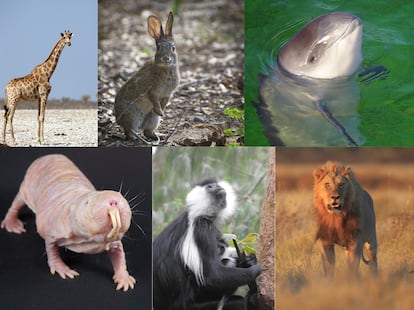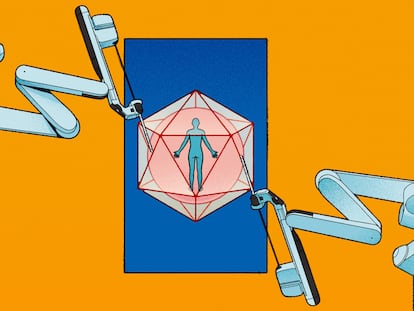A human accumulates as many mutations in 80 years as a mouse in its short life
A comparison between different mammals suggests the existence of a ‘natural law’ that links changes in cellular DNA to life expectancy

Giraffes that weigh up to 1,200 kilograms accumulate as many mutations in their cells throughout their lives as naked mole-rats, which rarely weigh more than 35 grams. Similarly, living beings as long-lived as humans and as short-lived as rats reach the end of their days with a similar number of changes in the DNA of their cells. Recent research comparing different mammals shows that there is a kind of natural law that links the life expectancy of each species to mutagenesis. This connection could shed light on processes as complex as cancer or aging.
Since the 1950s, many scientists in the field have linked aging with various processes of cell deterioration. One such process is somatic mutation. These are genetic changes, between 20 and 50 a year in humans, that occur in the life cycle of the cell. They occur in healthy cells, although some of them can trigger tumors or other alterations. Occurring at the cellular level, somatic mutations should be related in some way to body mass and life expectancy. The reason why a correlation with the first would be expected is because in theory, the greater the mass, the greater the probability of cancer developing in some cell. On the other hand, if mutations play an important role in aging, they would theoretically have a connection to life expectancy. So researchers at the Wellcome Sanger Institute (United Kingdom) specialized in genomic research decided to study these genetic alterations in 16 species of mammals, looking for patterns that pointed to a common basis in the decline of life over time.
The research, published a few days ago in the journal Nature, is new for many reasons. One is because of its comparative analysis of species that differ significantly in size, life expectancy or diet. It is also new in its analysis of somatic mutations within cells, something impossible to do until very recently. It is also novel because of the object of its study: cells from a part of the colon (called intestinal crypts) that have the particularity that they all come from the same stem cell, making it possible to accurately calculate the number of mutations they contain. But, above all, it is new because of its findings, which may have implications for some of the fundamental questions about human health and other living beings.
If it depended only on the number of cells, a mouse would never develop a tumor... and you would expect all whales to die of colon cancer before the age of 30, simply because of their sizeAdrián Báez-Ortega, researcher at Wellcome Sanger Institute and co-author of the study
The main finding is that the number of mutations per year or mutation rate is adjusted to the life expectancy of each species. Although very diverse, this rate is inversely proportional to longevity. Thus, while humans, with their life expectancy of around 80 years, have an annual rate of 47 mutations in the cells of each intestinal crypt, mice, with a survival rate of only two years, suffer 796. At the end of their lifetime, all the animals under study accumulated a similar number of mutations. In addition, researchers found that three of the main mutagenesis processes identified, such as the substitution of one base for another in the sequence, are shared between the different species. So there is a connection between mutation and aging. Another very different thing is to know how that connection works.
Adrián Báez-Ortega is a researcher at the Wellcome Sanger Institute and, together with Alex Cagan, is the main author of this research. He cautions about connecting somatic mutations in the cell with the aging process of organisms. “First, because we do not have data that would allow the results to be extended to other tissues beyond the colon. Second, because we have not studied it in other living beings that are not mammals.” Even more importantly, they do not know the meaning of this relationship. “We discovered a correlation between life expectancy and mutation rate, but we do not know if the mutation rate has evolved to adapt to the life expectancy of the animal or if the mutations affect this life expectancy,” highlights the Spanish researcher. It is certain, he says, that there are other factors at play as well. For example, colon cells accumulate about 50 mutations a year, but suffer thousands of instances of cellular damage. These damages appear to also play a role in senescence.
The work confirms one of the most intriguing paradoxes in molecular biology. It was raised almost 50 years ago by the British epidemiologist Richard Peto. He observed that species were beyond logic in terms of the risk of suffering cancer. If tumors are the result of mutations or harmful changes at the cellular level, the more complex the cell, the more tumors there should be. But reality shows that the incidence of cancer in animals does not seem related to body mass. This new study confirms the so-called Peto paradox.
“The incidence of cancer is similar between the species, even though they have differences in mass,” notes Báez-Ortega. In general, larger animals tend to live longer. Since all cells have the same chance of developing cancer, the larger the cells, the greater the risk, one might think. But no. “There is an incidence curve for cancer in humans that is known. If it depended only on the number of cells, a mouse would never develop a tumor, because it has far fewer cells and would not live long enough. Actually, they have an incidence similar to ours. And you would expect all whales to die of colon cancer before the age of 30, simply because of their size. But we see that evolutionary pressure has adjusted the rate of cancer, so that humans, elephants and mice have an almost identical curve once you control for their life expectancy. And we don’t know why this happens,” concludes the Spanish scientist.
The evolution of multicellular life requires carefully coordinating all cells so that each one plays exactly the right role in the organism. Somatic mutations can upset this balanceÍñigo Martincorena, head of research in somatic mutations in healthy and cancerous cells at Wellcome Sanger Institute
Íñigo Martincorena heads research on somatic mutation in healthy and cancerous cells at the Wellcome Sanger Institute in the UK. He is also a senior author on the research published in Nature. Regarding the main findings of the work, he recognizes how intriguing it is. “The evolution of multicellular life requires carefully coordinating all cells so that each one plays exactly the right role in the organism. Somatic mutations can upset this balance, as evidenced in the case of cancer, so the evolution of life has required controlling the accumulation of somatic mutations,” he says in an email exchange. So the finding that the somatic mutation rate per year is much lower in species that live longer “suggests that [these rates] are under evolutionary control.”
Regarding the relationship between mutations and aging, Martincorena insists that senescence does not have a single cause. “The most compelling hypothesis right now is that it is caused by the accumulation of various types of molecular damage in our cells, including somatic mutations, telomere shortening, protein aggregation, and epigenetic changes. We believe that these changes at the molecular level cause changes in our cells and tissues that give rise to the typical manifestations of aging.” But what’s not clear is how much each type of damage contributes. “Our results suggest that somatic mutations probably contribute to aging to some extent, but exactly how much and in what way remains to be demonstrated,” adds Martincorena, who concludes with an acknowledgment of the limitations of science: “If there is still much understand in cancer, in aging our knowledge is still much more primitive.”
Tu suscripción se está usando en otro dispositivo
¿Quieres añadir otro usuario a tu suscripción?
Si continúas leyendo en este dispositivo, no se podrá leer en el otro.
FlechaTu suscripción se está usando en otro dispositivo y solo puedes acceder a EL PAÍS desde un dispositivo a la vez.
Si quieres compartir tu cuenta, cambia tu suscripción a la modalidad Premium, así podrás añadir otro usuario. Cada uno accederá con su propia cuenta de email, lo que os permitirá personalizar vuestra experiencia en EL PAÍS.
¿Tienes una suscripción de empresa? Accede aquí para contratar más cuentas.
En el caso de no saber quién está usando tu cuenta, te recomendamos cambiar tu contraseña aquí.
Si decides continuar compartiendo tu cuenta, este mensaje se mostrará en tu dispositivo y en el de la otra persona que está usando tu cuenta de forma indefinida, afectando a tu experiencia de lectura. Puedes consultar aquí los términos y condiciones de la suscripción digital.
More information
Últimas noticias
The life of a delivery driver in China: ‘Many people don’t know how an order can arrive at their home in just one day’
Maude Apatow, from acting in ‘Euphoria’ to directing: ‘There are many films that you can tell weren’t written by someone young’
Mexico’s missing people crisis casts a shadow over World Cup venue
Helen Levitt, the photographer who captured the theater of the everyday
Most viewed
- Christian Louboutin: ‘Young people don’t want to be like their parents. And if their parents wear sneakers, they’re going to look for something else’
- US sanctions against jailed cartel leader ‘El Marro’ highlight Mexico’s lack of control over its prisons
- Cartels in Mexico take a leap forward with narco-drones: ‘It is criminal groups that are leading the innovation race’
- Liset Menéndez de la Prida, neuroscientist: ‘It’s not normal to constantly seek pleasure; it’s important to be bored, to be calm’
- ‘El Limones’ and the growing union disguise of Mexican organized crime











































